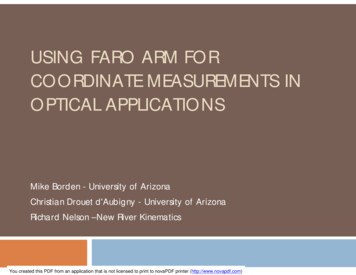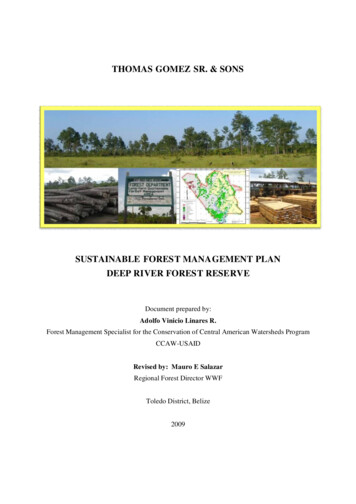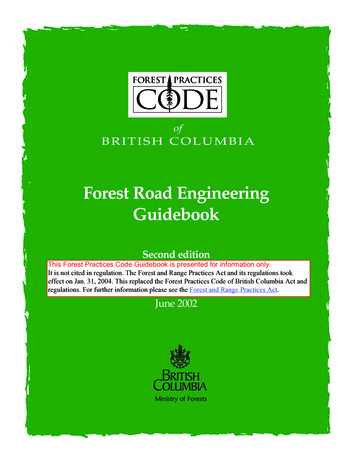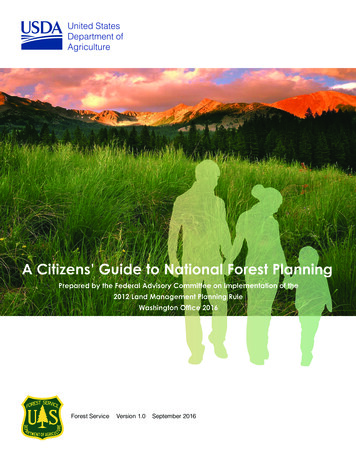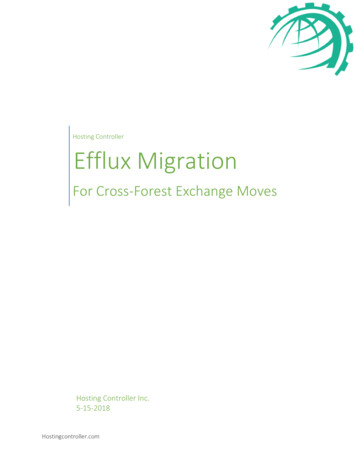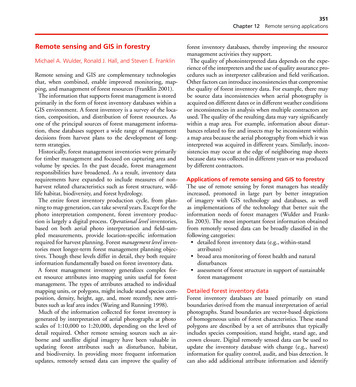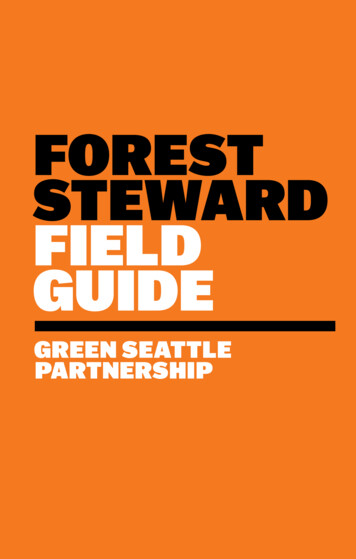
Transcription
FORESTSTEWARDFIELDGUIDEGREEN SEATTLEPARTNERSHIP
Thank you to all the partners who have contributed to the information in this guide.Design by André Mora with illustrations by Joel Kimmel.Printed in Seattle, WashingtonFor more information, contact info@greenseattle.org or visit greenseattle.org. 2020 Green Seattle Partnership
Table ofContentsIntroduction4 Dear Forest Steward5 Field Guide Purpose7 Why the Green Seattle Partnership?Forest Steward Program9 Being a Forest Steward11 The Role of a Forest Steward23 Ecological Restoration25 Tracking Progress (CEDAR)26 Seasonal Climate Considerations28 Site-Specific Considerations31 Access and Safety ConsiderationsRestoration Phases33 Phase 1: Invasive Plant Management49 Phase 2: Planting63 Phase 3: Plant Establishment65 Phase 4: Long-Term Stewardship and MaintenanceAppendices69 Appendix A: The Do’s and Don’ts of GSP70 Appendix B: Understanding Soil72 Appendix C: Calculating Mulch Needs74 Appendix D: Tips for Creating Tool Lists76 Appendix E: Estimating Square Footage77 Appendix F: Wet Area Decision Tree78 Appendix G: Native Plant List82 Appendix H: Woody Invasive Plant ListNotes & Contact83 My Park’s Plants86 Volunteer & Community Information88 Important Contact Information
4DEAR FOREST STEWARDWelcome to the Green Seattle Partnership (GSP)!The GSP Forest Steward Program provides youthe opportunity to be part of one of the largest,most unique community-based urban forest restoration efforts in the country. We have an ambitiousgoal to restore all 2,751 acres of Seattle’s forestedparklands by the year 2025 — and with your volunteer efforts, we can achieve it.This endeavor benefits both the environmentand local communities. To date, the work of manydedicated Forest Steward volunteers has beensubstantial. GSP and Seattle Parks and Recreation (SPR) staff stand by to assist in making yourexperience personally satisfying — and your effortshighly successful.While the thought of tackling invasive plantsin your neighborhood park may seem daunting,remember that you have the unyielding and fullsupport of the GSP program. As Forest Stewards,you will stand shoulder to shoulder with GSP andSPR staff, professional crews, other volunteers, andpartner organizations to get the work done. Youalso play the vital role of engaging your community— inviting new people into the urban forest andproviding them opportunities to volunteer in theirneighborhood park.This Forest Steward Field Guide contains basic,yet essential information you will need to startand implement site restoration plans, and trackyour progress. As a Forest Steward, you will haveopportunities to expand your forest restorationknowledge and skills by attending specializedtraining sessions. In addition, Forest Stewards ateach park are eligible to receive tools, materials,plants, and crew assistance for your restorationprojects through GSP.Thank you for taking the lead to restore, maintain, and steward our urban forests. Your commitment makes Seattle an even better place to live. Welook forward to many great years of cooperationand success!Sincerely,The Green Seattle Partnership
Introduction5Field GuidePurposeThis Field Guide is a quick reference for ForestSteward volunteers on how to get started and proceedwith community-based forest restoration at theirneighborhood parks.It does not have all of the answersto invasive plant management,community engagement, or speciesselection.The best available science drivesGSP work and is reflected within ourcurrent program policies. As urbanforest restoration is a relativelyyoung practice, GSP has had to buildmany of its own Best ManagementPractices (BMPs) to effectivelycomplete field work and maintain aconsistent quality of work across allGSP sites.On a broad scale, learning andinnovation occurs at restorationsites every day, the results of whichare captured in formal documentslike this Forest Steward Field Guide.BMPs are updated as new methodsare tested and deemed successful.Remember: Your feedback is essentialto our continuous learning process.RegulationsMany of the habitats where GSPworks, including wetlands, areecologically important and sensitive.As such, SPR has a responsibility tocomply with a variety of state andlocal regulations. The State Environmental Policy Act (SEPA) wasused as the basis to assess potentialenvironmental impacts of our restoration program and to issue projectrequirements that are embedded inthe BMPs.The City of Seattle has determinedthat if city staff, its contractors, andGSP volunteers comply with theBMPs, as referenced in this FieldGuide, then the program is in compliance with the regulations set forth inthe city’s Critical Areas Ordinances(CAO). Individual restoration effortsare assessed for compliance throughthe aforementioned regulatoryframework, but also could be subject to additional state and federalregulations.Full Best Management Practices documents can be found RESOURCES/
Introduction7Why the GreenSeattlePartnership?Our vision: Seattle is a livable city with healthy urban forestssupported by an aware and engaged community.The Green Seattle Partnership (GSP)is a unique public/private venturededicated to promoting a livable cityby re-establishing and maintaininghealthy urban forests. It was foundedin 2004 through a Memorandum ofUnderstanding between the City ofSeattle and Forterra (FORTERRA.ORG), aSeattle-based nonprofit that securesland to ensure a sustainable futurefor the Pacific Northwest. GSP is nowmanaged by the Natural ResourcesUnit of Seattle Parks and Recreation(SPR), with additional support provided by Seattle’s Office of Sustainability and Environment, Seattle Public Utilities, Forterra, other partnerorganizations, neighborhood groups,and individual volunteers.Seattle’s landscape has a historyof logging and urbanization that hasleft our natural areas in less thanideal conditions. Many of these areashave a canopy of short-lived deciduous trees, like red alder and bigleafmaple, and an understory that oftenis battling aggressive invasive plants.These conditions do not support theregeneration of a diverse native forest. Without intervention, we are atrisk of losing the quality forests ourcity needs.These forests provide a host of benefits to Seattle: cleaner air, cleanerwater, reduced stormwater impacts,reduced erosion, improved wildlifehabitat, and mitigated climate changeimpacts. Additionally, healthy forestsare attractive assets in Seattle’sneighborhoods and provide access tonature all across the city. GSP strivesto provide education and engagement opportunities for all Seattleites, empowers residents to make apositive change in their community,and encourages the next generationof Forest Stewards.GSP is committed to creatinghealthy forested parklands, supported by long-term communitystewardship and the establishment ofresources within the city.Our Goals1Restore and maintain the forestedparklands and designated naturalareas of Seattle.2Expand and galvanize aninformed, involved, and activecommunity around forest restorationand stewardship.In order for GSP to achieve thesegoals, we utilize volunteers, professional crews, community partners,and staff to advance our progressin restoring Seattle’s forestedparklands.
9Being a ForestStewardForest Stewards are dedicated and trained volunteerswho serve as the backbone of GSP. They build acommunity of stewardship around the city’s publicforested parks to safeguard their future.Forest Stewards commit to stewarding a specific park in collaborationwith SPR and their community.FOREST STEWARDRESPONSIBILITIESAND DUTIES Attend the GSP Forest Stewardorientation. Serve as key contact at a park forthe GSP. Coordinate volunteer forest res-toration events and activities inyour park; at least four volunteerevents per year (of any size), whereappropriate. Manage event postings and mate-rial requests, sign-in sheets, andwork logs on the CEDAR onlinedata portal. (See “What is CEDAR?”on page 10.) Participate in a biennial site-planning visit with GSP and SPR staffto agree on an identified plan forvolunteer work. Attend at least one Green Seattletraining event per year for ongoingpersonal development. Follow Best Management Practicesfor volunteers working on SPRproperty. Maintain a positive workingrelationship with staff, volunteers,donors, and community members. Stay in compliance with SPR background check requirement. Follow the SPR Volunteer Code ofConduct ION/VOLUNTEER/VOLUNTEERBEHAVIOREXPECTATIONS.PDF)
10B ei n g a Fo r est St e wa r dSeattle Parks and RecreationVolunteer Code of Conduct 1. As a volunteer, you represent SPR. Youmust treat the public, park users, othervolunteers, and SPR staff with respect. 2. Threatening or harassing behavior willresult in removal from the volunteerevent and could result in expulsionfrom the park.What is CEDAR?To simplify and streamline thedocumentation process for morethan 1,000 volunteer events a year,volunteers use CEDAR (CEntralizedDAta Repository), an online requestand reporting website. ForestStewards will receive a usernameand password, and be trained onCEDAR at their Forest Stewardorientation.3. Individuals must not be under theinfluence of alcohol or controlledsubstances while participating involunteer activities.4. Safety is of utmost importanceat all times. Take safety seriouslyand consider the use of safe workpractices for yourself and others as apersonal responsibility.5. Recognize parks as public places.All users have rights to the parks.Volunteer events are open to thepublic unless SPR staff has approveda closure or exclusive event.For more information about CEDAR, visit: SOURCES/CEDAR-HOW-TO
11The Role of aForest StewardThis section is intended to clarify the role of a ForestSteward. It will help you get your feet firmly plantedbefore you start digging in.STEPS TO FOLLOW1. Orient yourselfAttend GSP’s annual Forest Stewardorientation.2. Pick a siteTo be set up for success, your restoration site should be: Accessible (to volunteers and formaterials/support) Appropriate (for restoration activities performed by volunteers) Safe (not too steep or located alongbusy streets) Sturdy (sometimes wetlands orother sensitive areas are not thebest choice for volunteers)3. Schedule a site visitGSP staff will help Forest Stewardsestablish a site plan that identifiesspecific goals for ecological restoration. Some parks already have aVegetation Management Plan (VMP)established, in which case staff willhelp you interpret that plan. Staffwill clarify what work volunteerscan perform and identify areas thatmust be left for professional crews,such as slopes and areas in need ofherbicides. Site visits will cover thefollowing: The history of any prior forestrestoration work at your site. How to set a timeline forvolunteer events. The best area to focus volunteerwork in your first year. What SPR-approved Best Management Practices (BMPs) to use towork efficiently and effectively. Which plant species exist atyour site. A draft list of tools needed foryour work.For more information on Forest Steward resources, RD-RESOURCES,or go to GREENSEATTLE.ORG and search: FOREST STEWARD RESOURCES
12B ei n g a Fo r est St e wa r d4. Get familiar with your siteExplore your site to understand itsecological conditions, including sunexposure, water features, wet conditions, and signs of wildlife. Familiarize yourself with the site’s plantspecies and soil type (Appendix A).Visit the online GSP Reference Mapto view streams, delineated wetlands,slope conditions, Target Ecosystem,and Target Forest Type expectationsfor the zone you will be working in.5. Recruit volunteers andprepare for your eventOn the CEDAR portal, post yourevent, set up online registration, andrequest tools and materials. Conductoutreach for your event using GSPprinted materials, social media, networking sites, neighborhood blogs,and word of mouth. Print volunteersign-in sheets and make sure youhave the tools, materials, and snacksyou need to run a successful event.6. Host eventsPick up any coffee or snacks beforeyour event, and plan to arrive earlyto set up. Make sure your volunteersall sign in and have work gloves. Usethe Event Welcome and Safety Talkspeaking points on pages 18–20.Thank all volunteers and celebratethe work accomplished. Clean andput away tools, and have volunteersbrush their boots and shoes.7. Follow upFor each event you host, be sure tosubmit a work log and volunteersign-in sheet as soon as possible.If you are working independently,please record and submit hoursregularly. Timely submission of worklogs and volunteer sign-in sheets isimportant for tracking and reportingmonthly progress, and demonstrating this progress is key to attractingthe financial, political, and volunteersupport necessary to sustain theprogram into the future. CEDAR willautomatically send a thank you email,but you also could send personalizedemails to volunteers to thank themand invite them to your next event.8. RepeatContinue with volunteer events,reporting, and individual work. Thework will change throughout theseasons and over time as your siteprogresses through the phases ofrestoration. You will gain experience,expertise, and confidence with eachvolunteer event. Attend GSP workshops and training opportunities.Read up on the latest BMPs, and utilize GSP staff to help you grow in yourForest Steward role. Stay connected tothe GSP and Forest Steward community through social media, the ForestSteward Happenings monthly email,and the GSP monthly e-newsletter.COMMUNITY ENGAGEMENTForest Stewards often are the faceof the GSP’s restoration efforts. Youwill interact with volunteers, SPRstaff, park users, and the broadercommunity. Community engagementtools are available to you as a ForestSteward:To access the GSP Reference Map, visit SOURCES/GSP-RESTORATION-MAPor go to GREENSEATTLE.ORG and search: REFERENCE MAP
Being a Forest Steward13Allof your volunteer events will be publicized on a citywide website and theCity of Seattle’s volunteer calendar,by virtue of using the CEDAR portal. Advertise your events as a way forThesetemporary iconic green corrugatedplastic signs let park users knowa little bit about what is going onat the park and invite readers toparticipate in a volunteer event orcontact you about your restorationproject.site with GSP youth leadershipopportunities, including summerjob opportunities. G REEN SEATTLE EVENT CALENDAR FUTURE HEALTHY FOREST SIGNSSome parks have kiosksthat are available to you to publicize information about your restoration project or invite communitymembers to an event. K IOSK SIGNSIf you have a special event or an event you want tohighlight on the GSP social mediastreams, send them to:INFO@GREENSEATTLE.ORG. G SP SOCIAL MEDIAmiddle and high school students toearn community service hours thatmany Seattle schools require. Connect youth working at yourPlanning Youth Events A supervisor-to-youth ratio of 1:5to 1:7 is recommended. Supervisors can be other Forest Stewards,teachers, or parent chaperones. Prepare age-appropriate tasks foryouth volunteers. Plan multipletasks for a volunteer event so thatyou can be flexible if somethingisn’t working out well. Provide appropriate-sized toolsand equipment for youth volunteers, which can be requestedthrough CEDAR. Be prepared to provide snacks, orYOUTH ENGAGEMENTGSP has a specific goal to engageyouth in forest restoration effortsand train the next generation ofForest Stewards. You can help usreach that goal in a number of ways: Make your events family- andkid-friendly. Connect with teachers and administrators at schools nearby yourpark.arrange in advance for volunteersto bring their own snacks. Youth (under 14 years old) attending a regular volunteer event ontheir own need to be signed in bya parent or guardian or bring asigned youth waiver form withthem. Students attending a volunteerevent with their school or with anorganized group may have theirown youth waiver forms. In thiscase, the teacher or group leaderFor more information on the latest GSP outreach materials,visit ATIONRESOURCES/OUTREACH or go to GREENSEATTLE.ORG and search: PRINTEDOUTREACH MATERIALS
14B ei n g a Fo r est St e wa r dis considered the guardian andthe youth can sign-in like normal.Make sure all teachers, leaders, andchaperones also sign in.Event Logistics Give older kids a chance to helplead younger kids. Be mindful of event length. One-hour volunteer events are typicalfor elementary school students. Celebrate work accomplished andlessons learned. Ask youth volunteers to identify one thing that theyaccomplished or learned duringtheir work time.Fun and GamesHave students workin teams of two for planting. Havethem identify their plant species withID cards (if available) and make amulch donut.PAIRS PLANTINGHave studentscompete to remove the largest blackberry root ball, create the largestcompost pile, or pull the longeststrand of ivy.FRIENDLY COMPETITIONSelect three tofive leaves, berries, bugs or otheritems from your park and encouragethe youth to find them throughoutthe event.SCAVENGER HUNTTake a breakfrom the work and walk through thepark with the youth, pointing outinteresting features like nurse logs,snags, bird nests, animals, specialBIRD OR NATURE WALKplants, and human impacts.Engage youth in reporting by having them measure newlymulched areas, tally up plantingsand ivy rings, or estimate the size ofweeded areas.MATH SKILLSGSP INTRODUCTION FORYOUTH AND STUDENTSHere is an example of a script thatcan help you engage and inspire theyouth and students who have arrivedto volunteer at your GSP work site.Today, you are joining theGreen Seattle Partnership to workatPark.Who here has a favorite park inSeattle?(Expect answers related to soccer fields,spray parks, playgrounds, etc.) Thispark is a little bit different. Instead ofsoccer fields and jungle gyms, this parkis meant to be a forest.Who knows why healthy forestsare important for a city?Answers: They absorb and filter rainwater in a totally natural way. — Theyabsorb pollution in the air and providefresh clean oxygen. — “Take a deepbreath in! Thank you, trees!” — Theyprovide a living space for wildlife, likebirds, and a place for people to connectwith nature and the outdoors.Does anyone know how much forestedland is part of a Seattle park?For additional activities and educational lessons for youth,visit the Washington Native Plant Society resource page atWNPS.ORG/EDUCATION/RESOURCES/INDEX.HTML
Being a Forest StewardAnswer: 3.9 square miles. “About thesame size as 2,500 soccer fields!”To improve the health of all of thatforested land, we need the help ofeveryone in the city, “including youngpeople just like you!”The Green Seattle Partnership bringstogether people like you and me toextend the life of our forests so thatyou can enjoy them for many years tocome, maybe with your own childrenand grandchildren.BUSINESS ENGAGEMENTLocal businesses can help build yourvolunteer base, promote a healthierand cleaner forest, coordinate groupvolunteer efforts, and provide donations for your restoration events: Invite local businesses or businessassociations to volunteer at yourrestoration site. Ask local businesses if you canadvertise your neighborhood eventat their location. Partner with local businesses toprovide in-kind donations for yourvolunteer events, such as coffee,donuts, or healthy snacks. Review a guide for engaging yourlocal business community and utilize GSP’s outreach flyer by visitingGREENSEATTLE.ORG and searching:Business Engagement.15RACE AND SOCIAL JUSTICEINITIATIVEThe City of Seattle’s Race and SocialJustice Initiative aims to ensureracial equity in city programs andservices to make tangible differencesin people’s lives. GSP is a program ofthe City of Seattle, and is working toincrease participation of people ofcolor in our forest restoration efforts.GSP has set a goal to have volunteerhours completed by people of colorbe proportionate to Seattle’s race/ethnicity demographics as a whole.To measure our progress toward thisgoal, GSP asks for voluntary anonymous demographic information ofvolunteers when they register online,which includes race/ethnicity. ForestStewards may get questions aboutthe demographic survey. View themas your opportunity to explain theracial equity goal for the program.In addition to collecting demographic data at GSP volunteer events,GSP is working on other ways to meetthe goals of Race and Social JusticeInitiative: Build individual and programmaticknowledge of institutional racismby hosting at least one annual Forest Steward training that focuseson the topic. Build paid opportunities forminorities and underrepresentedgroups into GSP programming. GSP’s Public Engagement Com-mittee is tasked with applying anequity lens to all of our efforts andmaterials.
16B ei n g a Fo r est St e wa r dTHE 10ESSENTIALS OFA VOLUNTEEREVENT1 Volunteers!2 Restoration materials:plants, mulch, etc.3 Tools and work gloves4 Garbage bags for trashand, if needed, asmakeshift rain ponchos5 Signs for posting at parkentrance and sign-in table6 Sign-in materials:volunteer sign-in sheet,extra youth waiver forms,clipboards, pens, etc.7 Program and siteinformation: your siteplan, GSP brochures,dates for subsequentevents, etc.8 Work plan: clear goal ofrestoration work for theday9 Safety resources:first-aid kit, cell phone,nearby hospital or clinicinformation10 Water, coffee, andsnacksVOLUNTEER EVENTSEach group receiving GSP supportshould commit to holding at leastfour events per year, if appropriate.Volunteers can help with all fourphases of restoration — from theinitial removal of invasive plants towatering and maintaining plants.Volunteer events vary in size, froma small group of neighbors to a largercorporate outing. Forest Stewardsshould post all volunteer events tothe CEDAR online portal at least threeweeks in advance. This is to ensurethat there are no conflicting eventsin the park, and to allow GSP staff tobetter direct interested volunteersto your event and provide enoughtime to coordinate the necessaryresources.In addition to posting volunteerevents on CEDAR, Forest Stewardsare encouraged to do additionaloutreach to recruit enough volunteers for a successful event. GSP hascreated outreach materials that areavailable to Forest Stewards such asdoor hangers, kiosk posters, businesscards, and GSP brochures.Volunteers events are a greatway to get work done in the forest,but they also serve as importantopportunities to get people outsideand connected to Seattle’s parks.Forest Stewards can provide a funand rewarding experience for residents by being organized, friendly,prepared, and appreciative. To set upa successful volunteer event, prepareto have enough work and enoughevent leads for volunteers to get theinstruction they need to do meaningful work. Suggested work groupsizes are 10 to 15 for adults and five toseven for youth and student groups.Each group should have a knowledgeable leader, who can be another
Being a Forest StewardForest Steward or an experiencedvolunteer.GSP staff and professional crewsare available to help lead largerevents, as long as enough advancenotice is provided. Please contactGSP staff to request volunteer-eventsupport. If you cannot accommodatean interested volunteer group, pleaseask GSP staff for assistance or directthe requester to another scheduledGSP event.BE PREPARED1At least three weeks in advanceof your volunteer event, identifywhat work volunteers will be doing —and where. Considerations include:Is the worksite close to parking and restrooms?Will the restrooms be open for yourevent?ACCESS TO AMENITIESIs the site too steep for volunteers? Are there other site hazardsthat could impact negatively the volunteer experience, such as overheaddead trees, active bees nests, hightraffic areas (bikes/runners)?SAFETY KILL/EXPERIENCE LEVEL Is this workSappropriate for the skill level that volunteers will have? UCCESS Is the work plan somethingSthat could be accomplished in asingle event and provide a feeling ofsuccess?17 S EASONALLY APPROPRIATE WORKIs the work appropriate for theseason? For example, is it the mostopportune time to work in wet areas,install new native plants, work inbrushy areas where birds nest?Consult the GSP Seasonal calendaron pages 26–27 to get an idea of whatactivities are appropriate for the timeof year.Are there enoughknowledgeable leaders to support alarger volunteer event? E VENT LEADERS2Create a list of tools and materialsfor your event to ensure that youhave the right resources to accommodate your volunteers and get thework done. Request any materials,sani-cans, or extra tools through theCEDAR online portal at least threeweeks in advance. Learn more aboutcreating a tool list in Appendix D.3Conduct outreach to recruitvolunteers and encourage onlineregistration for the event.HOSTING YOUR EVENTAs a volunteer event leader, theForest Steward’s main jobs duringthe volunteer event are to explain tothe volunteers how the work impactsthe forest, teach volunteers how to dothe work, monitor work quality, andensure that volunteers are workingsafely and enjoying their time. It willbe tempting to dig in and do the workyourself, but a better investment ofAccess the CEDAR how-to guide at SOURCES/CEDAR-HOW-TO/
18B ei n g a Fo r est St e wa r dyour time is to make sure all volunteers are doing quality work. Followthese steps to ensure you cover allimportant points.1. Prepare for volunteers Be onsite and ready 15 to 30 min-utes before volunteers are scheduled to arrive. Make sure adequate signage isposted at the park entrance so volunteers can locate your site easily. Set out and count tools. Set out the sign-in sheet. Make sure any co-Stewards or leadvolunteers know the agenda andwork plan for the day.2. Event welcomeFeel free to customize or adapt thesetalking points as you get more comfortable leading volunteer events.I ntroduce yourself and other ForestStewards and/or GSP staff present.Thank everyone for donatingtheir time.Explain why it is so important thatpeople are participating— Healthy forests in our urban areasprovide many benefits includingimproved water and air quality,reduction in stormwater runoff, habitat, and improved public health.— Forest restoration work parties helpbring together communities, promotehealthy living, and make the park lookbetter.— Seattle has 2,751 acres of forestedparklands.— “These forests need our help!” Manyare dominated by relatively shortlived trees, such as red alder and bigleaf maple. The forest floor is beingtaken over by weeds like English ivyand Himalayan blackberry. Theseconditions are preventing the nativeforest from regenerating and creating a forest that is sustainable andlong-lived. xplain the Green SeattleEPartnership “The Green Seattle Partnership isa citywide effort that includes theCity of Seattle, Forest Stewards likemyself, many nonprofit partners, andresidents like you working togetherto restore all 2,751 acres of Seattle’sforested parklands.” (Consider providing a longer explanation or relatedactivity at a break/lunch.)Acknowledge tribal history “We are on the ancestral homelandsof the Duwamish and MuckleshootTribes, along with other Salish Tribesthat have lived here for thousandsof years. It’s our honor to workwith them in healing their ancestrallands.”Introduce your project— Give an introduction to your specificpark.— Touch on the history of the restoration and your long-term work plan.— If your group is appropriatelysized, have volunteers introducethemselves.Explain today’s activities— Today we are going to be:— Our schedule is going to be:— Bathrooms are located:— Water and snacks are located:
Being a Forest Steward3. Safety talkSet the tone for safety “While we are working today, ourmain goals are to be safe, have fun,and get some good work done —in that order.”General safety reminders “If you haven’t already signed in,please do so now.” (Pass around aclipboard, if needed.) Let volunteers know that you havea first-aid kit and tell them where itcan be found. Tell volunteers that they canalways call 911 for emergencies. Ifother issues arise, ask them to findyou. Also share that you have copies of incident and accident formswith you on site and share wherethey can be found.Tool safety Introduce what tools you are using,addressing all aspects of CUSS(Carry, Use, Safety, Storage) foreach tool. Remind volunteers to keep trackof tools and to return them to anidentified area before switching toa new tool. Remind everyone that they shouldbe wearing work gloves, whichyou are providing.Activity and environmentalconcerns Warn against heavy lifting. Explain that no work is to beconducted on steep slopes, or evenmoderate slopes (show areas thatare appropriate or inappropriate).19 If your event is close to a road,inform volunteers that they mustbe wearing safety vests and no oneshould be working in the road. Welcome water breaks and rest inthe shade. Be aware of ground nesting bees,and recommend that if volunteersget stung, they should run far andfast to escape other stinging bees;ask volunteers to identify (to thegroup or event lead) if they have abee sting allergy. Remind volunteers to not pick upitems from the work site that couldbe personal belongings (tents,clothes, etc.).Remind volunteers tonever pick up needles or syringes;notify the event lead so that thearea can be flagged off and reportedto SPR. Always wear gloves! Identify known areas of noxiousweed infestations that should beavoided,
4Dear Forest Steward 5Field Guide Purpose 7Why the Green Seattle Partnership? Forest Steward Program 9 Being a Forest Steward 11 The Role of a Forest Steward 23 Ecological Restoration 25 Tracking Progress (CEDAR) 26 Seasonal Climate Considerations 28 Site-Specific Considerations 31 Access and Safety Considerations Restoration Phases


